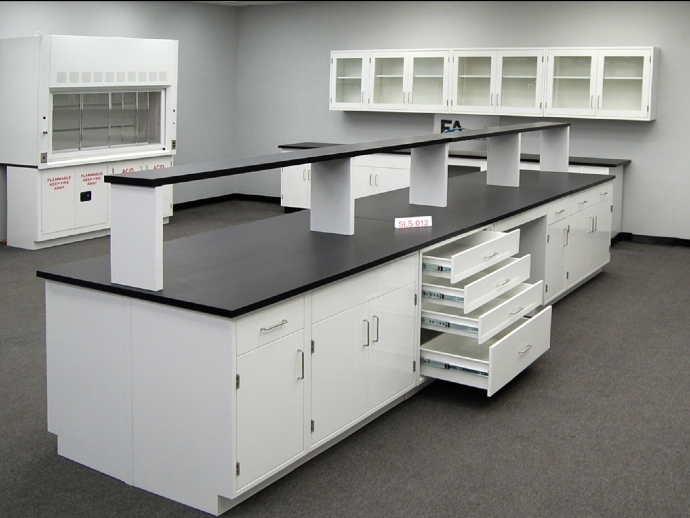Laboratory furniture is more than just benches and cabinets—it’s the backbone of a safe, efficient, and productive lab. Whether you’re outfitting a new facility or upgrading an aging space, your choices in lab furniture design can have a lasting impact on workflow, safety, and long-term operational success.
In this post, we’ll explore key considerations when selecting laboratory furniture, from ergonomic design and material durability to sustainability and tech integration.
Why Ergonomics Matters in Laboratory Furniture
A well-designed lab prioritizes ergonomics. When furniture fits the way people work, it reduces strain, prevents injuries, and promotes efficiency.
Look for these ergonomic features:
- Adjustable-height workbenches – Ideal for seated or standing work
- Smart storage placement – Reduces excessive reaching or bending
- Work surfaces with rounded edges – Improves comfort during long tasks
- Lighting and accessibility – Supports visibility and reduces fatigue
Designing with ergonomics in mind isn’t just about comfort—it’s about creating a healthier, more efficient workspace for lab personnel.
Best Materials for Durable and Functional Lab Furniture
Choosing the right materials is essential. Lab furniture must withstand heavy use, harsh chemicals, and frequent cleaning. Here’s a breakdown of popular materials and their pros:
| Material | Key Benefits |
|---|---|
| Stainless Steel | Corrosion-resistant, hygienic, easy to sanitize; great for biosafety labs |
| Epoxy Resin | Heat, moisture, and chemical-resistant; ideal for countertops |
| Phenolic Resin | Durable, scratch-resistant, and chemical-proof; commonly used on work surfaces |
| ESD Laminate | Prevents electrostatic discharge; used in electronics and cleanroom settings |
| Plastic Laminate | Cost-effective and easy to clean; not recommended for chemical-heavy areas |
| Maple/Wood Block | Offers aesthetic appeal, is less resistant to chemicals, best for dry lab use |
Always align your material selection with lab-specific needs—what works in a teaching lab may not suit a pharmaceutical environment.
Lab Safety Begins with Smart Furniture Design
Safety should be built into every part of your lab, starting with the furniture. Well-designed lab furniture reduces the risk of spills, injuries, and contamination.
Key features to consider:
- Built-in spill containment
- Chemical-resistant surfaces
- Safety shields or barriers near hazardous equipment
- Compliance with OSHA, SEFA, or other safety standards
By investing in safe furniture, you reduce downtime, protect personnel, and maintain a compliant workspace.
Flexibility and Modularity: Plan for the Future
Research environments change quickly, and your lab should be able to change with them. Modular lab furniture allows for:
- Easy reconfiguration without replacing furniture
- Expansion as team size or equipment needs grow
- Faster lab setup for new projects or programs
Modular systems are especially useful in multi-purpose labs or academic settings where flexibility is a must.
Technology Integration: Built-In Efficiency
Today’s labs are more tech-driven than ever. Furniture should support—not hinder—your instruments, computers, and data systems.
Design features to look for:
- Cable management channels to reduce clutter
- Built-in power and data ports
- Shelving or storage for instrumentation
- Secure mounting systems for monitors or devices
Well-integrated furniture ensures your digital tools are always within reach and ready to use.
Sustainability: Smart for the Planet and the Budget
Eco-friendly lab furniture isn’t just a trend—it’s a responsible choice. Many manufacturers now offer sustainable options that reduce your environmental footprint without compromising performance.
Sustainable features may include:
- Use of recycled or recyclable materials
- Low-VOC coatings and adhesives
- Energy-efficient production processes
- Certifications like LEED or GREENGUARD
Choosing sustainable furniture supports institutional green goals and can lead to long-term savings through durability and efficiency.
Conclusion: Invest in the Right Laboratory Furniture
Lab furniture is a foundational part of any lab’s success. The right choices in design and materials enhance safety, increase efficiency, and support your team’s work for years to come.
Whether you’re starting from scratch or modernizing an existing space, prioritize lab furniture that’s ergonomic, durable, safe, flexible, and future-ready.
Need help finding the right lab furniture solution? Explore our customizable options or talk to a lab design expert today.


